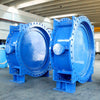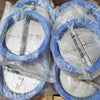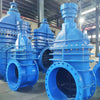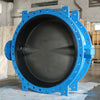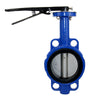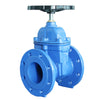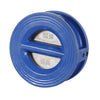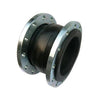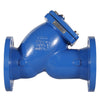What Is The Difference Between Wedge-Type Gate Valve And Slab Gate Valve?
A gate valve refers to a valve in which the closing component (gate) moves in a vertical direction along the flow of the medium. Gate valves are primarily used for shutting off flow in pipelines.
Among various types of valves, gate valves are the most widely used. They are generally only suitable for fully open or fully closed positions and cannot be used for regulation or throttling.
Based on the structure of the gate, gate valves can be divided into wedge gate valves and parallel gate valves. Today, we will discuss the characteristics and differences between wedge gate valves and slab gate valves.
Wedge Gate Valve
Since its invention in 1843 by the renowned British engineer James Nasmyth, the wedge design has been highly popular.
The sealing surface of the wedge gate valve is wedge-shaped, meaning it forms an angle with the central line of the gate. The gate is closed by the valve stem, and as the thrust of the valve stem increases, the pressure on the wedge-shaped sealing surface also increases, achieving a forced seal, which is particularly effective for sealing low-pressure media. Additionally, when the gate is opened, it immediately moves away from the valve seat, reducing wear on the sealing surface.
The wedge gate valve comes in three structural forms: wedge single gate, wedge flexible gate, and wedge double gate.

Wedge-Type Globe Valve Drawing
Wedge Single Gate Valve:
This type has a simple structure and is reliable, but it requires high precision in the sealing surface angle, making it more difficult to manufacture and maintain. It also has a higher risk of jamming due to temperature changes.
Wedge Double Gate Valve:
Commonly used in water and steam pipelines, this design requires less precision for the sealing surface angle and is less prone to sticking with temperature changes. The sealing surface wear can be compensated with gaskets. However, this structure has more parts and can easily adhere in viscous media, affecting the seal. Over time, rusting of the upper and lower stops can cause the gate to fall off.
Wedge Flexible Gate Valve:
This type retains the simplicity and reliability of the single wedge gate while offering slight elastic deformation to compensate for deviations in the sealing surface angle during manufacturing, improving its overall performance. It is now widely used.
Slab Gate Valve
The sealing surfaces of a slab gate valve are parallel to the vertical centerline, meaning the two sealing surfaces are parallel to each other.
Slab gate valves come in two types: single gate and double gate.

Slab Gate Valve Drawing
Single Gate Valve:
Sealing in single gate valves mainly relies on the medium pushing a floating gate or a floating seat to complete the seal.
Double Gate Valve:
Sealing in double gate valves is achieved through a spring or expansion mechanism between the gates. During the opening and closing process, the gate and the sealing surface of the seat remain tightly in contact.
Additionally, the gate can come with or without a flow diversion hole. The version with a flow diversion hole has the same diameter as the valve seat, making pipeline cleaning easier. It can be combined with the valve seat to create three types of seals: inlet end seal, outlet end seal, or both inlet and outlet end seals.
Differences between Wedge Gate Valves and Slab Gate Valves
1.Standards:
Wedge gate valves and slab gate valves each adhere to their respective standards.
2.Gate Shape:
Wedge gate valves have a wedge-shaped gate, while slab gate valves have a flat gate. The slab gate may also feature a flow diversion hole, which facilitates pipeline pigging and cleaning.
3.Difference in Stem Drive Torque:
Wedge gate valves require a higher torque to push the wedge-shaped gate downwards for sealing. In contrast, slab gate valves rely on the pressure of the medium to press the gate tightly against the seat, achieving the seal with less torque.
4.Difference in Electric Control Mechanism:
For electric wedge gate valves, a torque switch is needed to control the closing, as constant torque must be applied to push the stem and ensure sufficient pressure between the gate and the seat for effective sealing.
In slab gate valves, closing is controlled by a travel switch, which only needs to determine the position of the gate.
5.Adaptability to Media with Suspended Particles:
In wedge gate valves, the gate and seat are separated when open, allowing suspended particles in the medium to enter the sealing surface upon closing, which can result in poor sealing and damage to the surface.
In slab gate valves, the gate and seat remain in contact throughout the operation, preventing particles from entering the sealing surface, making them more suitable for media containing suspended particles.

6.Effect of Temperature Differences on the Gate:
When a wedge gate valve is closed, excessive temperature increases can cause thermal expansion of the valve stem, potentially leading to the gate jamming.
In slab gate valves, stem expansion does not affect the gate seal, and the gate will not become stuck.
7.Protection of the Stem in Rising Stem Valves:
In rising stem wedge gate valves, the stem is exposed and lacks a protective cover. In rising stem slab gate valves, the upper part of the stem has a protective cover, which shields the stem threads from dust and corrosion by rain, and often includes an indicator to show the valve's opening position.
8.Use of Sealing Grease on the Packing and Gate:
In wedge gate valves, sealing grease is generally not applied to the packing or gate sealing areas. In slab gate valves, grease is applied because the gate remains tightly pressed against the seat during operation. The grease improves lubrication, reduces wear, and enhances sealing performance. Grease applied to the packing also prevents it from drying out and ensures smooth stem operation by lubricating the seal.
These are the key characteristics and differences between wedge gate valves and slab gate valves. Choosing the right type of valve helps ensure efficient operation of pipeline systems. For more information, please contact Union Valve, a professional valve supplier.
Related Article:
- Why Gate Valves Leak and How to Fix It
- Characteristics of Resilient Seated Gate Valve and Their Differences from Metal Sealing Gate Valves
- Everything You Need to Know About Knife Gate Valves
- Choosing the Right Valves for Efficient Water Supply Systems

-
Posted in
Gate valve, Slab Gate Valve, Wedge-Type Globe Valve

